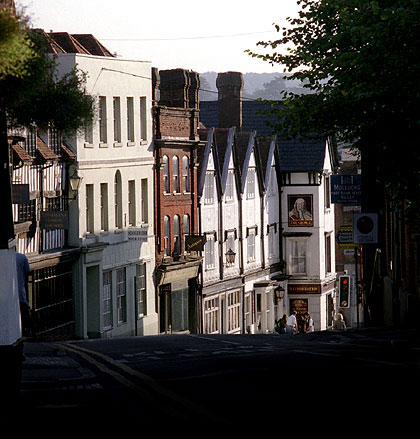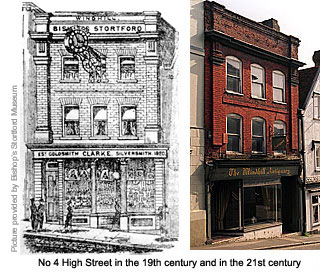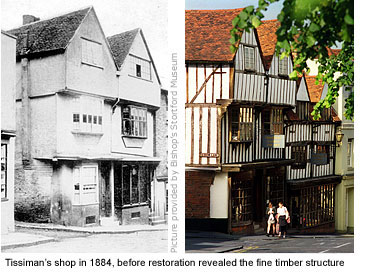|
|
|
 |
|
|
|
|
|
 |
|
 |
|
Mention the name ‘High Street’ and most people will immediately conjure up pictures of a long road lined with shops and businesses. Bishop’s Stortford’s High Street falls a little short of that image, its title probably owing more to the street’s elevation above the town than any commercial interest.
This is the heart of what was once the town’s medieval market place, a time when this thoroughfare was more commonly referred to as Cornmarket Street or Wheathill. Exactly when it was designated ‘Highe Streate’ isn’t clear, but up until the 18th century the name also encompassed the road beyond the crossroads now called Bridge Street. Only when a bridge was built across the shallow river crossing at the bottom of the hill did it become known as such, and High Street was then curtailed to its present length of approximately 200 metres.
In the Middle Ages, signs exhibited outside buildings were not confined to just inns, and the particular trade of a number of signs recorded in the town from that time cannot now be properly ascertained. With this in mind, it’s ‘possible’ that three inns were once resident in High Street – the names Saracens Head, Fleur Di Lis and The Crane all noted as having traded here. These are certainly names that conform to our present day imagery of a public house or inn but we will never really know if that’s what they were.
|
|
|
 Adjoining the George Hotel is No 4 High Street, a three-storey building of red brick originally built in 1740 as a private residence. It was converted into a shop in the 19th century and for a long time now has been home to the Windhill Antiquary – a somewhat misleading name considering the shop stands in High Street! Apart from the removal of a dividing wall on the ground floor to enlarge the shop area, the interior remains virtually unchanged since it was built. The walls of the entrance hall leading to the original staircase are still lined with wood panelling, and floorboards remain throughout, as do wood-clad ceilings. Adjoining the George Hotel is No 4 High Street, a three-storey building of red brick originally built in 1740 as a private residence. It was converted into a shop in the 19th century and for a long time now has been home to the Windhill Antiquary – a somewhat misleading name considering the shop stands in High Street! Apart from the removal of a dividing wall on the ground floor to enlarge the shop area, the interior remains virtually unchanged since it was built. The walls of the entrance hall leading to the original staircase are still lined with wood panelling, and floorboards remain throughout, as do wood-clad ceilings.
A building of different construction but from the same century is No 6, currently occupied by Stanley Tee Solicitors. In complete contrast to its neighbour, the Antiquary, so much alteration was carried out to this building’s interior around 1900 that very little of the original actually remains.
|
|
|
|
|
Tissimans
|
|
 The timber-framed structure of No 8 High Street was originally constructed in the 16th century as a small Wealden house. It was heightened to two storeys with attics in the 17th century, and re-fronted with brick and heightened, yet again, in the 19th century. The timber-framed structure of No 8 High Street was originally constructed in the 16th century as a small Wealden house. It was heightened to two storeys with attics in the 17th century, and re-fronted with brick and heightened, yet again, in the 19th century.
In the 1920s the Misses Bawtrees’ operated an employment agency for domestic servants from here, and in later years it became the Old House Tearooms. Not until Tissimans acquired the premises in 1968 to enlarge their adjacent shop was restoration work carried out, the brick frontage then removed to reveal the timber-frame structure we see today.
Tissiman’s main shop (No 10) is thought to be a Half Wealden house erected around 1500. It is the earliest known timber-frame building to be found in Bishop’s Stortford, and part of the site dates from the 14th century. But these premises have also undergone structural alteration – its height increased to three storeys in the late 1600s at about the same time it became a tailors shop called Slaters, themselves taken over in the late 18th century by Tissimans, established in 1601. A particular feature of Tissimans tailoring was the making of liveries for family estate retainers.
When the Great Earthquake of Essex occurred in 1884, ground tremors were so strongly felt on Windhill that staff of this tailors shop reportedly fled in panic. Panic of another kind was no doubt experienced by the shop’s past owner Jack Tissiman, who, while working in his tailor’s workshop late at night, often reported seeing the town’s most familiar ghost, the Grey Lady (See Guide 6).
After Jack’s death in 1971 the business was acquired by Golding of Newmarket, but continued to trade under the familiar name of Tissimans. Shortly before the death of his widow, order books and ledgers of the business dating from the late 18th century were deposited in the Hertfordshire Record Office. The shop has been in the ownership of Mr A.C. Arnold since 1996.
|
|
 Opposite Tissimans, dominating the corner of High Street and Church Street, stands a large, 19th century red-bricked building with two prominent gables. This was once the town’s prestigious High School, purpose built in 1850 on the former site of Bishop’s Stortford’s Grammar School, renowned for its academic qualities for almost 300 years. Opposite Tissimans, dominating the corner of High Street and Church Street, stands a large, 19th century red-bricked building with two prominent gables. This was once the town’s prestigious High School, purpose built in 1850 on the former site of Bishop’s Stortford’s Grammar School, renowned for its academic qualities for almost 300 years.
Pupils occupied a classroom in the larger, right-hand side of this building, and the headmaster’s quarters were on the left. Entrance to both was through the arched wooden door at the top of the small flight of steps. When the school moved to larger premises at Hadham Road in 1873, the building became St Michael’s Parish Hall, but was eventually sold by the Church in the 1960s. Although fundamentally the original structure, modernisation has turned the former classroom into a women’s hairdressing salon with offices above.
Bishop’s Stortford’s immense character and many fine old buildings have always held great appeal for artists. In view of this, Mr A.G. Tidmarsh of Bishop’s Stortford College decided to provide a local focus for those interested in sketching and painting, and in 1931 formed the Folio Club. The name comes from the fact that the club’s folio of artwork was passed around its members who then wrote their comments and criticisms on the back of each drawing. The Club spawned many good artists, one notable member being a local man named John Blake, whose sketches and watercolours of town scenes now hang on the walls of the Royal British Legion in Windhill (See Guide 4).
In November 1934 a major art exhibition was held at the Corn Exchange to raise funds for Bishop’s Stortford Hospital, and included many Art treasures and paintings loaned by local people as well as works by members of the Folio Club. The event was so successful it encouraged Mr Tidmarsh and a fellow art enthusiast, Octavius Wright, to invite members of the public to form the Bishop’s Stortford Art Society. On 21 November 1935 they held their first exhibition in St Michael's Parish Hall (pictured above), the event opened and attended by the Countess of Warwick of Easton Lodge. Inside, nearly three hundred items were put on display, including statuary, photographs, needlework, drawings and paintings.
The Art Society continues to flourish, holding regular exhibitions by local artists at various venues in the town. MORE PICTURES
|
|
|
|
[ BACK TO TOP ] |
|
|
|
|
|
|
|
|
|



 Adjoining the George Hotel is No 4 High Street, a three-storey building of red brick originally built in 1740 as a private residence. It was converted into a shop in the 19th century and for a long time now has been home to the Windhill Antiquary – a somewhat misleading name considering the shop stands in High Street! Apart from the removal of a dividing wall on the ground floor to enlarge the shop area, the interior remains virtually unchanged since it was built. The walls of the entrance hall leading to the original staircase are still lined with wood panelling, and floorboards remain throughout, as do wood-clad ceilings.
Adjoining the George Hotel is No 4 High Street, a three-storey building of red brick originally built in 1740 as a private residence. It was converted into a shop in the 19th century and for a long time now has been home to the Windhill Antiquary – a somewhat misleading name considering the shop stands in High Street! Apart from the removal of a dividing wall on the ground floor to enlarge the shop area, the interior remains virtually unchanged since it was built. The walls of the entrance hall leading to the original staircase are still lined with wood panelling, and floorboards remain throughout, as do wood-clad ceilings. The timber-framed structure of No 8 High Street was originally constructed in the 16th century as a small Wealden house. It was heightened to two storeys with attics in the 17th century, and re-fronted with brick and heightened, yet again, in the 19th century.
The timber-framed structure of No 8 High Street was originally constructed in the 16th century as a small Wealden house. It was heightened to two storeys with attics in the 17th century, and re-fronted with brick and heightened, yet again, in the 19th century. Opposite Tissimans, dominating the corner of High Street and Church Street, stands a large, 19th century red-bricked building with two prominent gables. This was once the town’s prestigious High School, purpose built in 1850 on the former site of Bishop’s Stortford’s Grammar School, renowned for its academic qualities for almost 300 years.
Opposite Tissimans, dominating the corner of High Street and Church Street, stands a large, 19th century red-bricked building with two prominent gables. This was once the town’s prestigious High School, purpose built in 1850 on the former site of Bishop’s Stortford’s Grammar School, renowned for its academic qualities for almost 300 years.